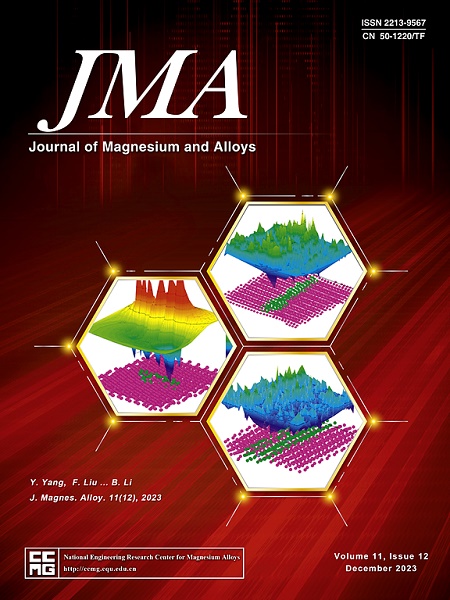Strengthening mechanism and corrosion behavior of friction stir welded LAZ933 magnesium-lithium alloy
IF 15.8
1区 材料科学
Q1 METALLURGY & METALLURGICAL ENGINEERING
引用次数: 0
Abstract
In this study, friction stir welding (FSW) technique was applied to the LAZ933 magnesium-lithium (Mg-Li) alloy. Microstructure, mechanical properties and corrosion behaviors of friction stir welded LAZ933 magnesium-lithium alloy were analyzed by optical microscopy (OM), scanning electron microscopy (SEM), X-ray diffractometry (XRD), transmission electron microscopy (TEM), hardness, tensile, and electrochemical test. The experimental results indicated that FSW resulted in significant refinement of β phase, reduction of α phase content as well as dissolution of Mg17Al12 and AlLi (γ) precipitates in the nugget zone (NZ). The generated MgLi2Al (θ) precipitates in the NZ and heat-affected zone (HAZ) which had a coherent structure with the matrix could significantly strengthen the Mg-Li alloy. The ultimate tensile strength of the joint reached 163.5 MPa, and elongation reached 15.21%. In the weakest area of the weld (HAZ), the strengthening caused by the solid solution of α phases and formation of θ precipitates compensated the strength loss induced by the phase coarsening by thermal exposure in FSW, resulting in the joint fractured in the base metal (BM) and showed a ductile pattern. The corrosion current density changed from 4.831 × 10−5 A/cm2 to 2.054 × 10−5 A/cm2, which indicated that the weld had better corrosion resistance than the BM.
搅拌摩擦焊LAZ933镁锂合金的强化机理及腐蚀行为
本文章由计算机程序翻译,如有差异,请以英文原文为准。
求助全文
约1分钟内获得全文
求助全文
来源期刊

Journal of Magnesium and Alloys
Engineering-Mechanics of Materials
CiteScore
20.20
自引率
14.80%
发文量
52
审稿时长
59 days
期刊介绍:
The Journal of Magnesium and Alloys serves as a global platform for both theoretical and experimental studies in magnesium science and engineering. It welcomes submissions investigating various scientific and engineering factors impacting the metallurgy, processing, microstructure, properties, and applications of magnesium and alloys. The journal covers all aspects of magnesium and alloy research, including raw materials, alloy casting, extrusion and deformation, corrosion and surface treatment, joining and machining, simulation and modeling, microstructure evolution and mechanical properties, new alloy development, magnesium-based composites, bio-materials and energy materials, applications, and recycling.
 求助内容:
求助内容: 应助结果提醒方式:
应助结果提醒方式:


